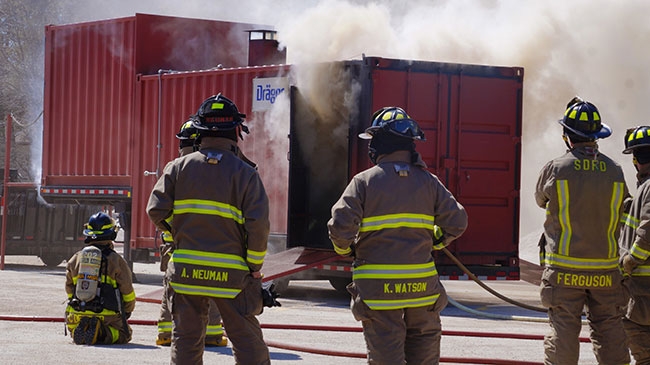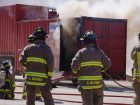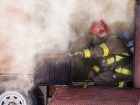
Features
Training
Live fire training
Have you thought about live fire training in your department? Today’s fires occur with less frequency, but when they occur the fires are far more dangerous than they were 20 years ago.
May 18, 2018
By Lance Bushie
 First-hand experience and muscle memory are key pieces of comprehensive training. Have you thought about live fire training in your department?
First-hand experience and muscle memory are key pieces of comprehensive training. Have you thought about live fire training in your department?Firefighters need to be aware of the rapid and dangerous fire behaviour that can occur in modern building construction. New research is becoming available all the time from UL/NIST that challenges previous training and traditions. A wider choice of tactical considerations are now available to the incident commander that previously were taboo. An example is transitional attack — also called “resetting the fire” — which uses exterior water application to control the gas fire even if firefighters or occupants are in the building.
In the past firefighters received ample real-life training on the scene of fires. With the frequency of fires on the decline (thank you fire prevention officers and fire codes), firefighters don’t have the same number of opportunities to learn the necessary skills and gain experience. This gap must be closed by conducting realistic live fire training.
I’ve been in the fire service for 28 years. I progressed from joining as a volunteer in 1989 to moving through the ranks to fire chief and director of protective services. Through my career I have always had a passion for instructing. In my experience, firefighters are lacking the basic understanding of fire science and how it relates to rapid, dangerous fire behaviour and extinguishment of modern buildings and contents. We all take two hours of lecture in NFPA 1001 Level 1 at the beginning of our fire training and may never touch the subject again unless you are a training officer. Take a moment and think about how important it is to have an in-depth knowledge of fire and its behaviour? It’s imperative that firefighters be highly proficient in how fire develops, warning signs, control measures and efficient extinguishment. Tactics and strategies based on traditions, or “this is the way we’ve always done it,” are no longer acceptable. Every firefighter must have the ability to judge their surroundings and be situationally aware and apply the right tool from the tool box at the right time.
There’s a Latin saying, “sine scientia ars nihil est” that translates to “skills without knowledge is nothing.” Do you or your firefighters understand the knowledge behind the skills we employ?
What do you do as a training officer to close the gap? Conduct live fire training drills. Why? My experience has shown that the true understanding of the principals of fire attack are gained with the combination of classroom, demonstration and student application in a realistic environment gaining firsthand experience and muscle memory. This is the standard approach to training. Fire behaviour and tactics can only be mastered by teaching the knowledge, demonstrating the knowledge and having the firefighter perform the skills while explaining the why behind the skill until proficient.
Before live fire training, paperwork needs to be done and standards followed. The 2018 NFPA 1403 standard on live fire training is available and there are new updates that every department should be aware of. If you are unaware of the standard, go the NFPA.org and read it. The standard is based on hard lessons learned; training fires that have killed and injured. I highly recommend that your jurisdiction adopt the standard if this hasn’t occurred already.
The standard covers engineered live fire props and acquired structures. Acquired structures require large amounts of work to prepare the structure for safe evolutions. The department I’m from once used acquired structures for training. We stopped due to an incident involving an officer and a firefighter being involved in a flashover. They narrowly escaped. Soon after this incident we invested in the Swede Survival Phase 1 Class A Flashover unit from Draeger.
I’m a huge advocate of using live fire props that are engineered and built with specific training objectives in mind combined with an experienced training officer who has the ability to fully control the fire (and as it should go without saying, also meets NFPA 1403 requirements). I have been the instructor in charge of training in Phase 1 for the past 11 years and the Draeger Phase 1 meets all the above requirements. The department also invested in the Phase 2 interior attack trainer, Phase 5 multi storey live fire trainer and the Draeger System 64 with a variety of props which all meet the above requirements.
There are several updates to the 2018 NFPA 1403 standard, which include:
- Instructor In Charge (IIC): The IIC is now required to meet 1041 Level 2. All other instructors involved in the live fire training are required to meet the NFPA 1041 Level 1.
- Written learning objectives are required for all live fire evolutions. Weather conditions must be monitored and limits on wind and heat established to ensure safe burning conditions.
- The IIC shall not serve as the ignition officer for more than one burn in a row.
- Prohibited fuel types have been added to include tar paper and carpeting.
- Students minimum training requirements before participating in live fire training are outlined in 1001 Level 1: safety, fire behaviour, extinguishers, PPE, ladders, hose streams, overhaul, water supply, ventilation, forcible entry and building construction. Newly added are specific training on the fire dynamics of flashover, health and safety, fundamentals of fire behaviour, compartment fires, nozzle techniques and door procedures. Students must rehab in accordance with NFPA 1584 Chapter 6.
- NFPA 1584 Chapter 6 rehab rules also apply to all the instructors involved in the live fire training.
Classroom training should also include the required knowledge of fire behavior, dangerous rapid fire behaviours, interior fire attack tactics, thermal imager basics, PPE limitations and construction, all of which prepare the student for the dangers modern fire behaviour present.
Practical skills must be demonstrated and practiced; hose handling skills reviewed and practiced. LA County Fire Training Division has some great videos available for nozzle handling and deployment. Nozzle skills covering stream patterns and application rates are highly recommended. Hose movement and positions specifically focusing on the prone position should be covered. The training should then proceed to door entry procedures and the transitional attack. All must be taught, demonstrated and performed by the students prior to live fire drills.
Live fire training can be conducted with a high degree of safety and efficiency. The key is using props that simulate actual fire behaviour while ensuring firefighter safety. Care must be taken to ensure the training and tactics taught are relevant to the real world fires of today. Too often we teach tactics to the burn building we train in. In the past we had hay and pallets for fire. Those didn’t create the heavy dense smoke and fire behaviour that occurs in a real compartment fire with a large fuel load of petroleum based furniture and wall coatings.
The warning signs of rapid fire behaviour must be observed and techniques practiced to cool the environment, control rollover and delay flashover. Some fire training buildings are Class B and can be great for teaching and allow students to master skills that require muscle memory. The Class A props demonstrate far more realistic compartment fire behaviour, however the amount of water we apply in this environment isn’t representative of the amounts required to cool the gases generated by fires encountered during an interior attack on modern fire fuel loads. Students will remember exactly the way they were taught and repeat those skills when under pressure. Training props need to reflect the learning objectives that you are trying to achieve. These props must replicate the conditions of the objectives so that the reactions of the students will be the same on the fire ground. How many times as an instructor have you said “But in the real fire we would…” Insert any statement like: “be lower to the ground, apply more water, not be able to see.” See where I’m going with this? As instructors we need to provide the firefighter as realistic an experience as possible as they will replicate exactly as we have taught them when faced with the conditions and stress of the fire environment.
Train hard and stay safe.
Lance Bushie is the lead instructor at Trident Fire Training & Consultancy Inc. www.tridentfire.net
Print this page

